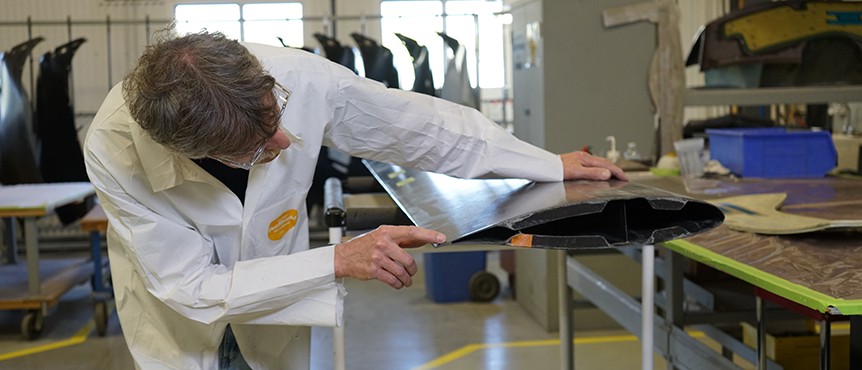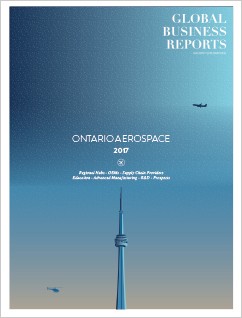Ontario must upgrade its established advanced manufacturing industry, embrace disruptive technologies and promote innovation.
RELATED PUBLICATION
ARTICLES FROM THIS PUBLICATION
Ontario’s Aerospace R&D Ecosystem

Although Ontario’s legacy of advanced manufacturing has carried the aerospace industry into the 21st century, the sector can no longer rest its weight on history. The aerospace industry is at a crossroads, and companies need to steer away from their traditional mindset to embrace disruptive technologies and lead the world in innovation. “To elevate the aerospace industry and become globally competitive, the region should adapt new technologies available,” said Joris Myny, senior vice president for process industries & drives division at Siemens.
Ontario has the capabilities in place to adopt innovative technologies and break away from the legacy aerospace industry. The region has a high concentration of assets including incubators and accelerators, contributing to the innovation ecosystem. Ontario also hosts approximately 18 universities and colleges offering 40 aerospace-specific programs. For example, McMaster University’s Manufacturing Research Institute (MMRI) collaborates closely with OEMs, engine providers and the aero parts supply base through a range of research programs. Additionally, the University of Ontario Institute of Technology’s (UOIT) ACE allows for aerospace companies to test and validate their research in a unique facility. The University of Waterloo, Carleton University, and Conestoga College all work with industry partners on aerospace-related research from blade coatings to aircraft design.
The Downsview Park Aerospace Campus is a unique collaborative project between academic institutions, industry players, and government institutions. Key stakeholders are part of the Downsview Aerospace Innovation and Research (DAIR) consortium and contribute to the efforts of building the aerospace campus that will be the hub for integrated research, industry-leading innovation, and entrepreneurial business development. The University of Toronto Institute for Aerospace Studies (UTIAS) and Centennial College are both relocating aerospace programs to Downsview to further collaborate with the industry in research. The Downsview hub is an initiative for the aerospace industry to stay at the global forefront for R&D and innovation. “We need to create this beacon to the world where they can come to Ontario and access the newest R&D projects and be at the cutting edge of innovation,” said Andrew Petrou, director for DAIR.
Associations play a role in bridging the gap between industry and academia. Consortium of Aerospace Research and Innovation in Canada (CARIC) has 14 projects in Ontario establishing collaboration between the aerospace industry and academic research centers and helps the region strengthen its aerospace network while innovating to better compete globally. Denis Faubert, president of CARIC said: “We create awareness of R&D processes and opportunities to help companies understand how they can benefit from these types of programs. The basis of our program is to connect the industry and academia to collaboratively work on R&D projects.”
Even with strong academic institution and associations supporting collaborative research initiatives, government support is imperative. “Strategic investments by our government partners heavily leverage industry investments both in terms of accessing existing infrastructure and talent and also by providing matching funding on research performed at the MMRI and through generous R&D tax credits,” said Stephen Veldhuis, director of MMRI.
Both the federal and provincial governments provide programs and incentives supporting the aerospace industry in Ontario, allowing companies to invest in innovation. Fed Dev Ontario’s mandate since 2009 is to support the innovation ecosystem. To some extent, government programs also facilitate SMEs access to funds, allowing them to incorporate the latest technology to remain globally competitive. Brotech Precision CNC has leveraged opportunities such as the Southwestern Ontario Development Fund to incorporate cutting-edge technology. However, government institutions still need to play a stronger role to ensure SMEs invest in innovation and new technology. SMEs continue having difficulty financing the capital investment required. “Reducing costs goes hand in hand with R&D and technological development, and therefore smaller companies require financial support from the government,” said Daniel Zanatta, vice president of Magellan Aerospace.
Industry 4.0
As manufacturing sectors have taken a hit in recent years, there is the necessity to increase productivity and efficiencies, transitioning into the fourth industrial revolution, or Industry 4.0. “Assembling a plane is still manually intensive, and fully leveraging advanced operations, advanced analytics, and the Internet of Things will be important. Aerospace should be a leader in looking at new automated technologies for manufacturing,” said Bruce Simpson, senior partner at McKinsey.
Automation is an important part of Industry 4.0. With the high mix, low volume nature of aerospace manufacturing, SMEs in Ontario have been slow in implementing automation. However, there needs to be an understanding that automation can still enhance productivity and help lowering costs for aerospace companies, even with the low-volume quantities of manufacturing. Automation for aerospace manufacturing will still require labour, but can increase quality and precision of production. Koss Aerospace, located in Mississauga, has incorporated automation technologies into its manufacturing processes in order to achieve faster cycle times and reduce costs, and other companies need to follow suit to increase productivity.
The Internet of Things (IoT) is another important facet of Industry 4.0. The next generation of aircraft will arguably be powered by IoT. However, big data and smart data can also be incorporated into manufacturing processes. Companies such as UTC Aerospace Systems are investing into a digital strategy to guide their operations into the future with Industry 4.0. Aerospace companies need to invest in new technologies now to not be left behind in the rising storm of the fourth industrial revolution. Jeff Gazidis, business development for aerospace at Siemens highlights: “Industry 4.0 is a journey and change will not happen overnight.”
Environmental initiatives
The outlook for R&D in Canada will include trends relating to environmental sustainability. In regards to the increasing emphasis on carbon credits and jet engines’ effects on the atmosphere, Nathan Cheifetz, partner at Blakes, comments: “Soon there will be a new world-wide system, with pressure all the way down the manufacturing chain to OEMs and suppliers of different components to meet these new standards.”
Environmental sustainability is an area for collaborative research between universities and aerospace companies. For example, UTIAS collaborated with Bombardier and Pratt & Whitney on a project dedicated to developing an environmentally sustainable aircraft.
Fortunately, sustainable technologies often go hand in hand with cost reduction. Aerospace parts with new materials, such as composites or titanium, not only reduce weight, resulting in lower fuel consumption, but also ensure cost optimization. Therefore, beyond the pressure to increase environmental sustainability, aerospace companies are seeing the aggregate benefit in doing so. “Going towards the future, it is important to support innovation in the aerospace industry, and to support those looking for more green technology with faster and more ecologically-friendly methods”, said Heidi Clark, senior partner at Dentons.
Emerging markets such as Mexico or China are heavily investing to create the aerospace capabilities Ontario already has in place. These countries are developing their infrastructure both in manufacturing as well as in academic institutions. In these regards, Ontario already benefits from having a strong foundation. Therefore, the region needs to leverage the R&D ecosystem comprising of academic institutions, associations, and industry players in order to elevate the aerospace sector. Ontario needs to stay ahead of the game and lead the industry at the forefront of innovation and into the fourth industrial revolution. Denis Faubert, president of CARIC, highlights: “Ontario’s aerospace industry continues making capital investments and we expect long-term growth for the sector.”











